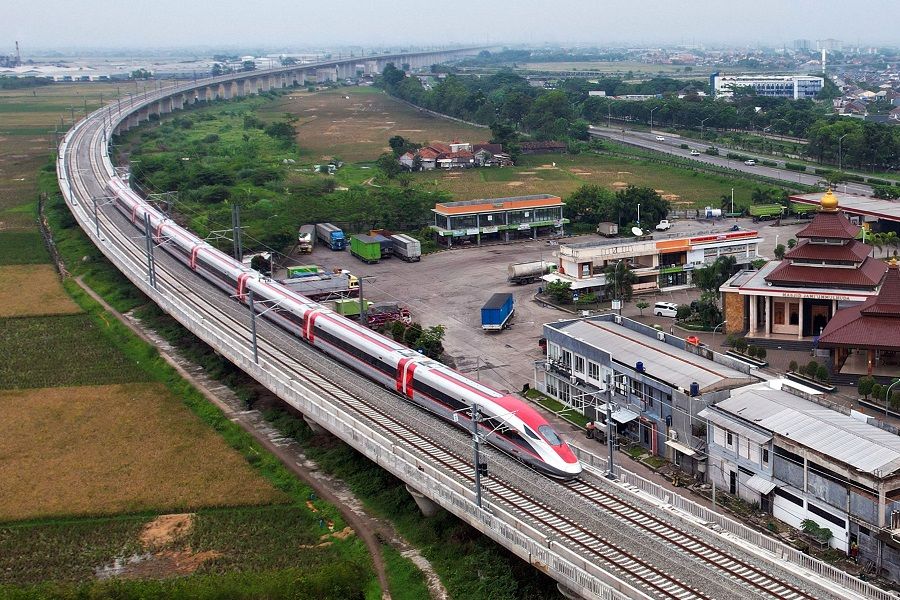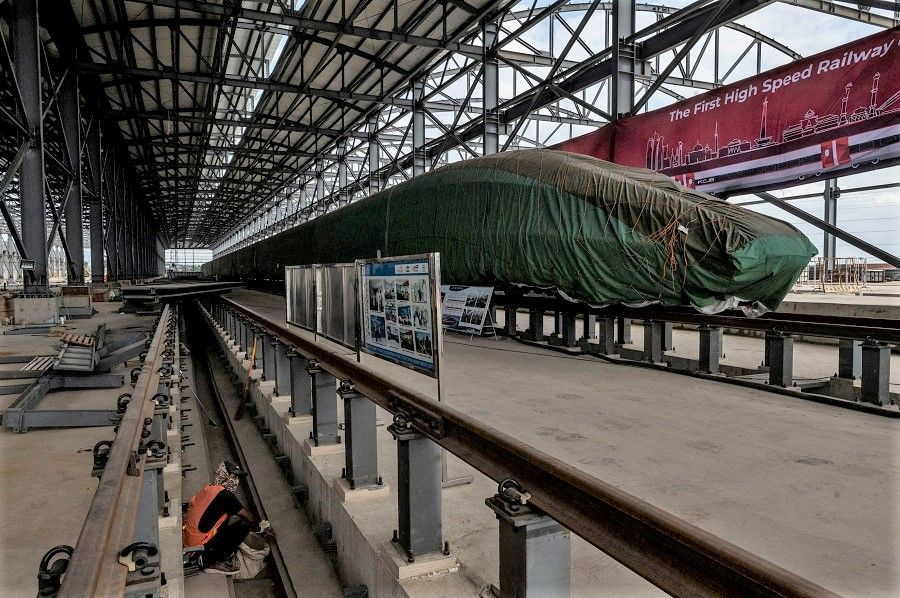How China helped build Indonesia's high-speed rail

(By Caixin journalists Yang Min, Wen Simin, Ying Chuyan and Bonnie Cao)
A silver-bodied high-speed train decorated with a flash of red rolled slowly out of the Tegalluar station in Bandung, Indonesia's West Java province, last month, and everyone applauded.
The spectators included Chinese President Xi Jinping and Indonesian President Joko Widodo. They witnessed the operational trial of the Jakarta-Bandung high-speed train on 16 November on the sidelines of a bilateral meeting following the G20 Summit in Bali.
The Jakarta-Bandung railway is a landmark project under China's Belt and Road Initiative as the country expands its presence in Southeast Asia. It also represents a key step in the Indonesian government's infrastructure push. The line connects Indonesia's capital Jakarta and Bandung, the nation's fourth-largest city.
The 142.3 kilometre (88.2 mile) railway is set to begin commercial operation in June 2023. It will make Indonesia the first country in Southeast Asia with a high-speed railway and will cut travel time between Jakarta and Bandung to around 40 minutes from more than three hours.
The line is the first overseas rail project to fully use Chinese railway systems, technology and industrial components. From the railway design and engineering construction to operating management, the Jakarta-Bandung railway deploys Chinese technology. The key equipment was manufactured by Chinese enterprises.
Infrastructure boom
Indonesia, a nation of a thousand islands, has yet to build a fully integrated national transportation network, especially railroads and waterways, creating a bottleneck for economic development and for attracting foreign investment.

Jakarta and Bandung are on Indonesia's most-populated island of Java, home to 150 million people, or nearly 60% of the country's population. More than 30 million people live in greater Jakarta.
In 2008, the Indonesian government set out to build a 700 kilometre high-speed rail line between Jakarta and the country's second-largest city, Surabaya, also on Java. The Jakarta-to-Bandung section is the first phase.
The stability of China's government was an important reason that Indonesia eventually selected the Chinese proposal because high-speed railways take years to complete...
Bandung is a popular tourist destination and a center of Indonesia's textile industry. Completion of the high-speed railway will directly improve communication and logistics between Bandung and the financial centre of Jakarta and drive the construction of light rail and other supporting transportation facilities, alleviating urban traffic congestion.
Since he took office in 2014, Widodo has pursued ambitious infrastructure plans. His government planned to build 2,659 kilometres of roads, 1,000 kilometres of highways, 3,258 kilometres of railroads, and 24 large ports, requiring US$424.5 billion in capital. The government introduced public-private partnership regulations to provide a more flexible legal framework for attracting private investment in infrastructure.
Such a grand scheme with enormous market potential attracted interest from Japan and China. Japan submitted a bid for the Jakarta-Bandung railway, China's Vice Foreign Minister Xie Feng told the press when he was still China's ambassador to Indonesia.

In its final bid, China promised to produce and hire locally while maximising the use of local raw materials and machinery. It also agreed on technology transfers to support the long-term development of Indonesia's railroads.
The stability of China's government was an important reason that Indonesia eventually selected the Chinese proposal because high-speed railways take years to complete, a person familiar with the bidding process told Caixin at the time.
Disputes involving land acquisition were the main holdup, reflecting complex government and private land ownership in the densely populated island.
A project with challenges
PT Kereta Cepat Indonesia China (KCIC), the consortium building the railway, was established as a joint venture of four Indonesian state-owned companies and China Railway International, a subsidiary of China Railway Group.
Construction was scheduled to begin at the end of 2015, and the project was originally expected to be complete by 2018 and start operation in 2019, Xie said upon signing the investment agreement in 2015. KCIC will hold the operation rights for 50 years. However, the project was delayed because of higher land acquisition costs, budget overruns and the Covid-19 pandemic.
Disputes involving land acquisition were the main holdup, reflecting complex government and private land ownership in the densely populated island. Multiple rounds of negotiation among the government, local companies and residents slowed the project.
Construction is also difficult on Java amid volcanoes and earthquakes. The high-speed rail line, equipped with an earthquake monitoring and an early warning system, adopts intelligent sensing technology, a person involved in the construction told Caixin in Indonesia.

"We have learned the rules of the game, technical standards and culture of the local Indonesian market through this project," the person said. "The practical experience we gathered will be helpful for our future projects."
Construction came to a halt in March 2020 amid the pandemic. With about US$2 billion of overruns, the total cost is estimated to reach US$7.36 billion. - PT Kereta Cepat Indonesia China
China Railway opened a factory in Indonesia, hired 2,000 to 3,000 local workers, and taught them building skills step-by-step, from tying steel bars to erecting beams. It will also train the local operating and management company after the railway goes into service. "The build-up of the ecosystem will be beneficial for Indonesia's sustainable development," the person said.
Construction came to a halt in March 2020 amid the pandemic. With about US$2 billion of overruns, the total cost is estimated to reach US$7.36 billion, according to KCIC.
"Simply providing masks and other pandemic-related supplies increased the expenses of Chinese suppliers a lot," said a person close to the project.
In June 2022, all 13 tunnels of the rail line were completed. In September, an initial set of Chinese-made train cars reached Jakarta. A test of a trial section was conducted on 9 November.
Infrastructure battleground
Southeast Asia has become a battleground for major powers trying to build influence through infrastructure investments.
With the Belt and Road Initiative, China has become one of the most important infrastructure investment forces in Southeast Asia. China's investments have expanded from traditional projects into digital, telecommunications and smart city infrastructure.

Several major China-led projects have been completed in recent years, including a China-Laos railway, Myanmar's Kyaukpyu port and a China-Myanmar gas pipeline. A China-Thailand high-speed rail line and a China-Myanmar railway are also underway.
China's Belt and Road Initiative is gradually altering that balance, making it inevitable that the US would seek to bolster its influence in the region. - Liang Haiming, chairman and chief economist, China Silk Road iValley Research Institute
To counter China's growing influence in the region, the Group of Seven advanced countries proposed a Partnership for Global Infrastructure and Investment in June 2022. The plan aims to raise US$600 billion over five years for infrastructure projects in developing countries. The US will raise US$200 billion, mainly from federal funds and private investment. The EU will raise 300 billion euros (US$317 billion) over the next seven years for sustainable global infrastructure and health facilities, according to European Commission President Ursula von der Leyen.
Southeast Asia has long balanced economic dependence on China and security dependence on the US, said Liang Haiming, chairman and chief economist of the China Silk Road iValley Research Institute. China's Belt and Road Initiative is gradually altering that balance, making it inevitable that the US would seek to bolster its influence in the region, Liang said.
The US invested a large amount in building infrastructure overseas during the Cold War, and its investments today aim to compete with China, said Chong Ja Ian, an associate professor at the National University of Singapore.
This article was first published by Caixin Global as "In Depth: How China Helped Build Indonesia's High-Speed Rail". Caixin Global is one of the most respected sources for macroeconomic, financial and business news and information about China.
